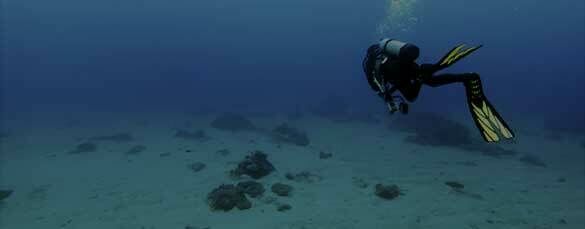Intracardiac shunts
1. Right to-left shunts
[Reviewed 4 December 2022]
After a dive which allows venous bubble formation, a diver who has an intracardiac right-to-left shunt is at risk of paradoxical gas embolism, which can result in neurological decompression illness(1,2). The evidence suggests that divers with such shunts are at risk, even when they perform dives which are inside acceptable and safe decompression tables (or algorithms) (1). The risk of decompression illness by this mechanism is related to the tissue nitrogen-load (i.e. pressure-time profile), the size of the shunt and presence of other factors likely to cause right-to-left shunting (3,4). Approximately one quarter of the population have a patent foramen ovale or a small atrial septal defect, but the risk of paradoxical embolism is much greater in those with larger shunts (3). Decompression illness is very unusual in sport divers after dives to less than 20 metres and we have not observed neurological decompression illness that appears to be the result of paradoxical embolism in sport divers after dives to that depth. We have observed neurological decompression illness associated with a large shunt in a professional diver who did a working dive at 18 metres, which required in-water stops that were performed correctly (5).
 |
It therefore seems reasonable that sport divers known to have an intracardiac shunt should be allowed to dive shallower than 15 metres, provided no other cardiac contraindication exists. If a diver with a shunt wishes to go deeper than 15 metres the options include use of nitrox with an air decompression table (to reduce bubble liberation and tissue nitrogen-load) and use of a table such as the DCIEM table which is believed to result in little or no bubble nucleation. It will also be possible for some individuals to return to unrestricted diving after transcatheter closure of the defect (5). 1t is hoped that, with further understanding of the mechanisms involved it may be possible to vary this advice at a later date. |
2. Haemodynamically important shunts
A small proportion of the population have large and haemodynamically important shunts (e.g. large ASD, large VSD or PDA). In those cases other factors, including haemodynamic consequences of the shunt (e.g. predisposition to pulmonary oedema), will also need to be considered.
| 3. Small pure left-to-right shunts
Small ventricular septal defects, in individuals with otherwise normal hearts, only shunt left-to-right and have little haemodynamic effects. Asymptomatic individuals with a small ventricular septal defect can be allowed to dive without restriction. |
 |
References:
1. Wilmshurst PT, Byme JC, Webb-Peploe MM. Relation between interatrial shunts and decompression sickness in divers. Lancet 1989: 2: 1302-6.
2. Moon RE, Camporesi EM, Kisslo JA. Patent foramen ovale and decompression sickness in divers. Lancet 1989; I: 513-4.
3. Wilmshurst PT, Davidson C, O’Connell G, Byme C. Role of cardiorespiratory abnormalities,
smoking and dive characteristics in the manifestations of neurological decompression illness. Clinical Science 1994; 86: 297-303.
4. Wilmshurst PT, Treacher DF, Crowther A, Smith SE. Effects of patent foramen ovale on arterial saturation during exercise and on cardiovascular responses to deep breathing, Valsalva manoeuvre, and passive tilt: relation to history of decompression illness in divers. British Heart Journal 1994; 71: 229-31.
5. Wilmshurst P, Walsh K, Morrison L. Transcatheter occlusion of foramen ovale with a button device after neurological decompression illness in professional divers. Lancet 1996; 348: 752-3.



